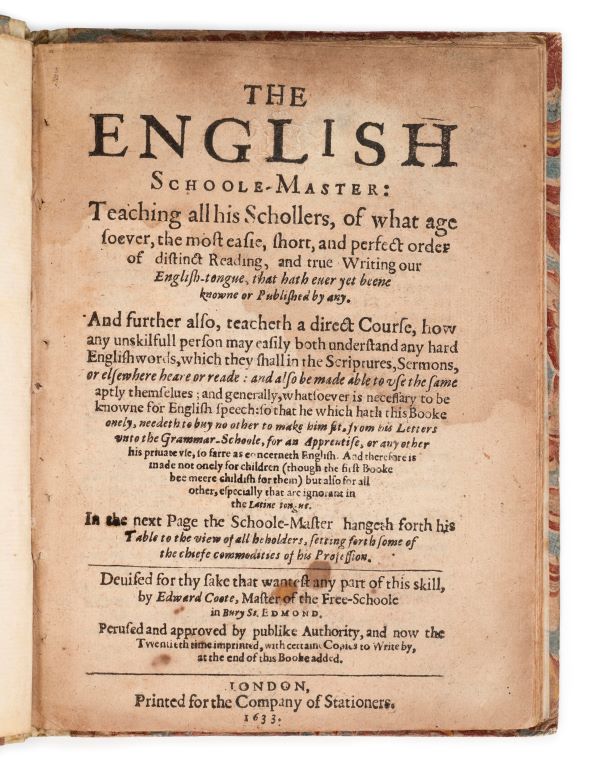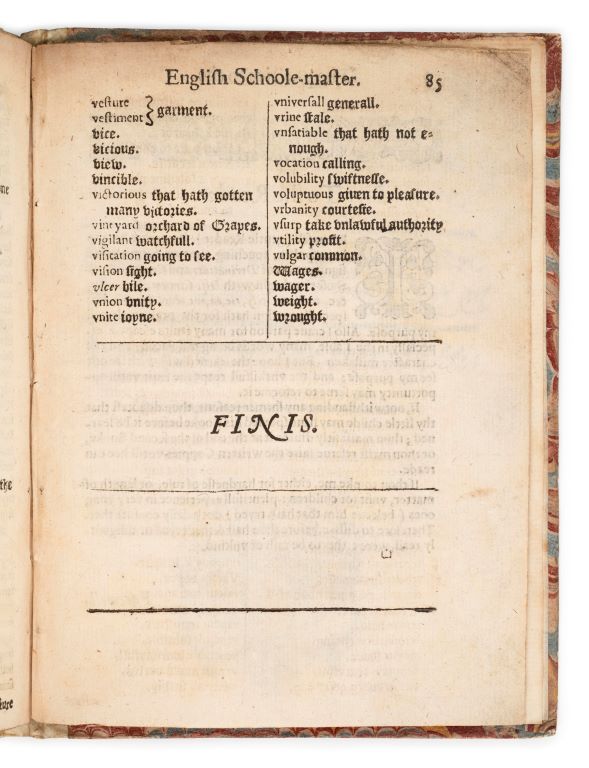I was surprised that I wrote so much about prices in my recent post about the unique copy of Louis-Lucien Bonaparte’s Dialects of England and Scotland presented to Henry Baird. After all, as I’ve reiterated, the value of the books in Madeline Kripke’s collection has little to do with the prices at which she bought them, and I promised not to cherry-pick the costliest items from the collection. Nevertheless, I recently encountered Madeline’s copy of a genuinely rare work, Edward Coote’s The English Schoolmaster — not the even rarer first edition of 1596, but the edition published in 1633 — which she purchased from Rulon-Miller Books on 17 December 2019 for $27,560. (Rulon-Miller had listed it for $32,000, so we see Madeline, not for the first time, bargaining with dealers, perhaps trading on special relationships with dealers from whom she frequently purchased items.)

As sometimes happens with expensive books, The English Schoolmaster is not long, just eighty-eight pages front to back. Coote was “Master of the Free School in Bury St. Edmond,” or the Edward VI School, where he propounded this teaching philosophy:
I Professe to each thee, that art vtterly ignorant, to Reade, perfectly, to Write truely, and with judgement to vnderstand the reasons of our English-tongue with great expedition, ease and pleasure.
Apparently, educated writers were already contesting the Oxford comma. To write “truly” means to write correctly, and looking backwards from the twentieth century, we notice that what’s correct depends on the time and place in which one writes. In any event, regardless of spelling, Coote sounds to have been a hard schoolmaster. As Nicholas Orme has recently illustrated in his book Tudor Children (2023), the utterly ignorant pupils at free schools invented lots of games in response to pedagogical tyranny, so Coote was undoubtedly an inspiring teacher, if not quite in ways he expected. There’s a lot of social history implied in The English Schoolmaster, some of it in the book and others like it, some of it in the school room and school yard. One doubts that the book itself provoked the pleasure Coote invoked — spelling, grammar, and glossary lookups rarely do.
Coote taught reading syllable by syllable, rather than by letters or words, and for several pages he laid down rules, but the rules were put into practice and the pain of learning them alleviated by a series of dialogues, first between scholar and master, then between scholars. Gradually, then, young readers became independent of their master, which was good, because they didn’t spend all that many years at school, free though it was — they were needed in the world at large. Having become capable readers by page thirty-two, they turned their attentions to religious instruction; access to the Bible and the Book of Common Prayer were the principal reasons for learning to read in the first place, followed by the value of literacy in commerce. Coote provided them with a brief catechism and “Sundry necessary observations of a Christian,” followed by a selection of Psalms, which were a focus of congregational reading during the Anglican liturgy.
Madeline would have been interested enough in The English Schoolmaster up to this point, but the glossary that follows a brief section on arithmetic clinched that interest. The glossary belongs in the “hard words” dictionary tradition. Glosses and brief glossaries had been a feature of Latin instruction for a long time, but the practice had migrated into textbooks of English, like Coote’s. Later, printing made it possible for schoolmasters to support their pupils’ learning by drawing glosses together into a single book, initiating the tradition of “hard word” dictionaries, first of which was Robert Cawdrey’s A Table Alphabeticall (1604), followed by Henry Cockeram’s The English Dictionarie, or An Interpreter of Hard Words (1623). By the time the 1633 edition of The English Schoolmaster appeared, it had become routine for textbooks to gloss over gaps in their pupil’s lexical knowledge.

Coote’s work served as a model for hard-word dictionaries. There were, however, few enough models for Coote to follow, and he did the best he could, compiling his glossary after long days in the classroom. He glosses allegation (a truly hard word for schoolchildren) as ‘alleging,’ which is quite inadequate, defining a word with another formed from the same base, allege, which was likely no less mysterious to his pupils. He treats amorous more successfully, as ‘full of love,’ a gloss made of words schoolchildren would readily understand. Perhaps Coote was a reluctant lexicographer, or perhaps one night his attention faltered, but when he sent his text to the printer, the last four words of the glossary — wages, wager, weight, and wrought — lacked glosses. Nonetheless, the glossary stretches from page 66 to page 85, nearly a quarter of The English Schoolmaster, which suggests something about its value to relative to other parts of the book — I haven’t yet decided what that something is.
I wonder what Coote’s pupils and others subjected to The English Schoolmaster — it saw many editions in the seventeenth century — made of it. Were they as bored as I suspect? Or was school novel enough at the time that such a book would please its youthful audience? These larger questions interest me more than the book per se. I realize, though, that someone deeply interested in the history of pedagogical technique might respond differently, whereas someone interested in the rise of teen culture would respond more enthusiastically to the Dobie Gillis Dictionary or the pink plastic covered dictionary whose definitions we are expected to dig, both described in earlier posts. It serves us all well that nearly everything interested Madeline, the venerable and the ephemeral, the expensive and the cheap, the artifact and the advertisement for it, the workbook supporting it, the censorship exercised against it. The broad range of dictionaries and related works she collected was not random because it was broad, however. Rather, it is a carefully curated representative view of lexicography in real life, the best example of each thing worth our consideration.
Leave a Reply